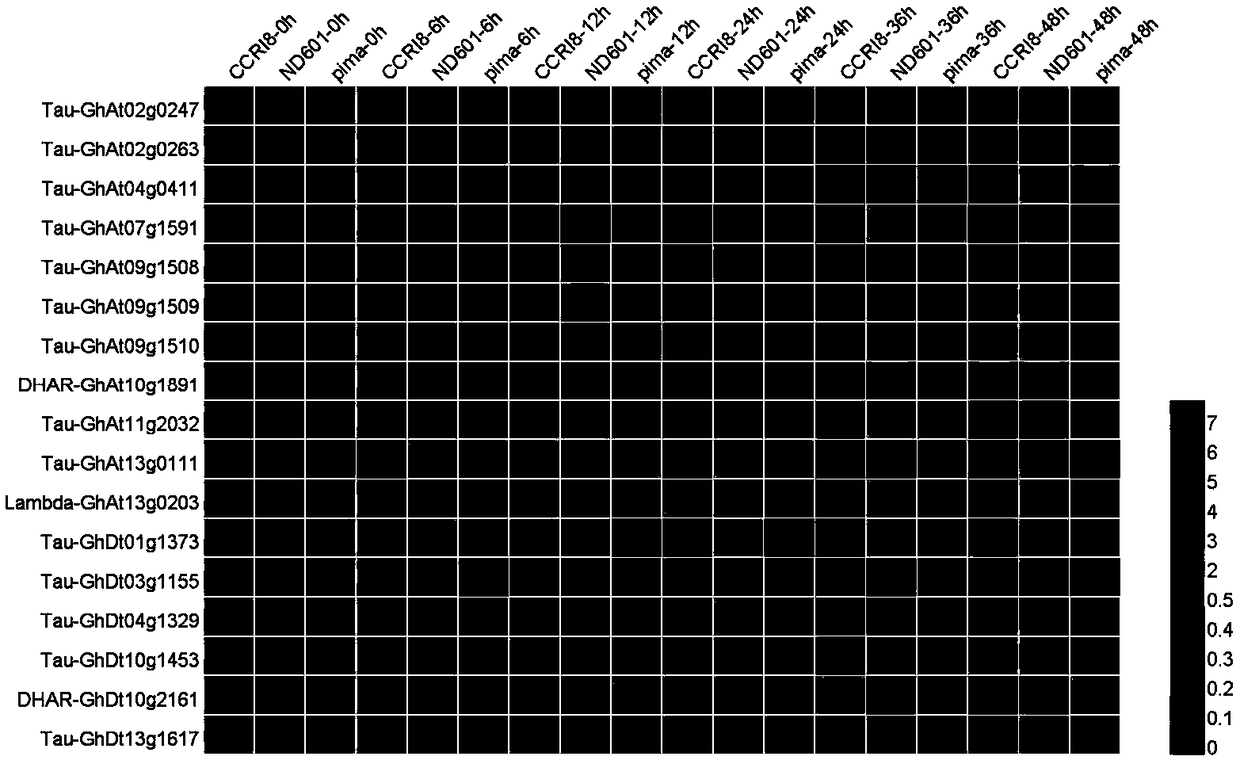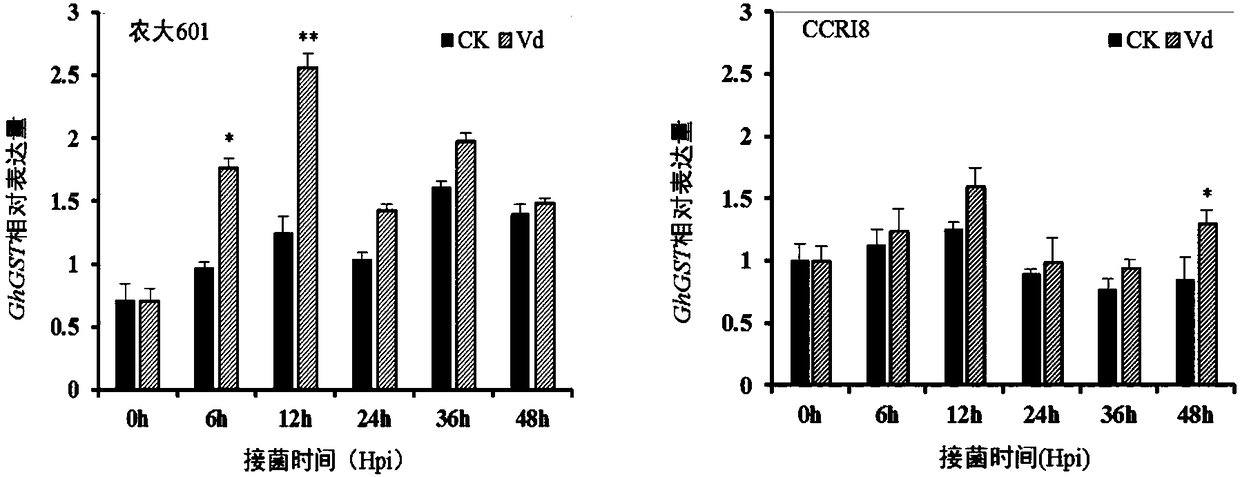GST gene cluster of upland cotton and application thereof in improving verticillium wilt resistance of plants
A technology of gene clusters and upland cotton, applied in the field of upland cotton GST gene clusters and its application in improving plant resistance to Verticillium wilt, can solve problems such as single breeding method, narrow genetic basis of upland cotton, and slow breeding progress
- Summary
- Abstract
- Description
- Claims
- Application Information
AI Technical Summary
Problems solved by technology
Method used
Image
Examples
Embodiment 1
[0031] Example 1 Functional Analysis of Upland Cotton GST Gene Cluster
[0032]The GST gene family analysis of the upland cotton genome found for the first time that two homologous tau clusters (including Gh_A09G1508, Gh_A09G1509 and Gh_A09G1510; Gh_D09G1520 and Gh_D09G1521) were undergoing genetic innovation and gene rebalancing in the genome after the formation of upland cotton. A homologous cluster was located on chromosome 9 of subgroups A and D of upland cotton. Through transcriptome, VIGS (virus-induced gene silencing) and overexpression experiments, it was proved that the cluster in subgroup A played an important role in the cotton Verticillium wilt resistance response, while the homologous cluster in subgroup D was degenerating ( One of the genes has been lost when passed from Raymond to upland cotton, one half is lost, and one is not expressed). This result strongly proves that the cluster located in subgroup A may have experienced higher selection pressure, and this...
Embodiment 2
[0035] Example 2 Acquisition of Cotton Verticillium Wilt Resistance Genes GhAt09g1508, GhAt09g1509 and GhAt09g1510
[0036] According to the sequencing results of Upland cotton TM-1 genome (Li et al., 2015; Zhang et al., 2015), the following primers were designed:
[0037] GhAt09g1508:F:TTGATATCATGGGCGAAGAAGTGCAGGTTTTTTGGC and R:TTGGATCCTCATTGGGAAAGACTAGCTTTGAC GCGhAt09g1509:F:GCTGAGCTCTTAGGCCTTAGCATTATCTT and R:AGAGGATCCATGGGTGAAGAAGTGAAGGhAt09gCCGAT09g1510:F:CCGAATTCGAGGAGTCGAATGGGTGAAGRAGGT
[0038] The genes GhAt09g1508, GhAt09g1509 and GhAt09g1510 were respectively cloned from cotton variety Nongda 601.
[0039] The nucleotide sequences of the genes GhAt09g1508, GhAt09g1509 and GhAt09g1510 are respectively shown in SEQ ID NO: 1-3.
Embodiment 3
[0040] Example 3 Functional analysis of genes GhAt09g1508, GhAt09g1509 and GhAt09g1510
[0041] 1. Functional analysis of the core gene Gh_A09G1509 of the upland cotton GST gene cluster
[0042] 1.1.qRT-PCR analysis showed that under the induction of Verticillium dahliae, the expression of Gh_A09G1509 in the roots of the resistant variety Nongda 601 was higher than that of the susceptible variety CCRI8, and the expression level was the highest at 12 hours after inoculation (Verticillium dahliae) ( figure 2 ), indicating that the gene is involved in the interaction between cotton and Verticillium dahliae.
[0043] 1.1.1 Planting and cultivation of sterile cotton seedlings
[0044] The seeds of Nongda 601 and CCRI8 were develored with concentrated sulfuric acid, rinsed with clean water and dried. Soak in clean water for 12 hours, change the water 2-3 times during the period, soak the white seeds with 0.1% mercuric chloride in an ultra-clean workbench for 1 minute, then steril...
PUM
 Login to View More
Login to View More Abstract
Description
Claims
Application Information
 Login to View More
Login to View More - R&D
- Intellectual Property
- Life Sciences
- Materials
- Tech Scout
- Unparalleled Data Quality
- Higher Quality Content
- 60% Fewer Hallucinations
Browse by: Latest US Patents, China's latest patents, Technical Efficacy Thesaurus, Application Domain, Technology Topic, Popular Technical Reports.
© 2025 PatSnap. All rights reserved.Legal|Privacy policy|Modern Slavery Act Transparency Statement|Sitemap|About US| Contact US: help@patsnap.com



